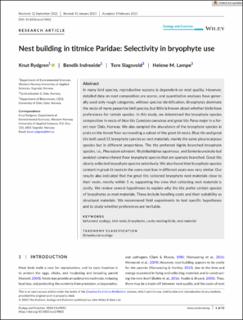| dc.description.abstract | In many bird species, reproductive success is dependent on nest quality. However, detailed data on nest composition are scarce, and quantitative analyses have generally used only rough categories, without species identification. Bryophytes dominate the nests of many passerine bird species, but little is known about whether birds have preferences for certain species. In this study, we determined the bryophyte species composition in nests of blue tits Cyanistes caeruleus and great tits Parus major in a forest near Oslo, Norway. We also sampled the abundance of the bryophyte species in plots on the forest floor surrounding a subset of the great tit nests. Blue tits and great tits both used 15 bryophyte species as nest materials, mainly the same pleurocarpous species but in different proportions. The tits preferred highly branched bryophyte species, i.e., Pleurozium schreberi, Rhytidiadelphus squarrosus, and Sanionia uncinata but avoided common forest floor bryophyte species that are sparsely branched. Great tits clearly collected bryophyte species selectively. We also found that bryophyte species content in great tit nests in the same nest box in different years was very similar. Our results also indicated that the great tits collected bryophyte nest materials close to their nests, mostly within 5 m, supporting the view that collecting nest materials is costly. We review several hypotheses to explain why the tits prefer certain species of bryophytes as nest materials. These include handling costs and their suitability as structural materials. We recommend field experiments to test specific hypotheses and to study whether preferences are heritable. | en_US |

